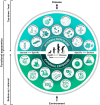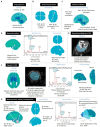The science of uncertainty guides fetal-neonatal neurology principles and practice: diagnostic-prognostic opportunities and challenges
- PMID: 38352135
- PMCID: PMC10861710
- DOI: 10.3389/fneur.2024.1335933
The science of uncertainty guides fetal-neonatal neurology principles and practice: diagnostic-prognostic opportunities and challenges
Abstract
Fetal-neonatal neurologists (FNNs) consider diagnostic, therapeutic, and prognostic decisions strengthened by interdisciplinary collaborations. Bio-social perspectives of the woman's health influence evaluations of maternal-placental-fetal (MPF) triad, neonate, and child. A dual cognitive process integrates "fast thinking-slow thinking" to reach shared decisions that minimize bias and maintain trust. Assessing the science of uncertainty with uncertainties in science improves diagnostic choices across the developmental-aging continuum. Three case vignettes highlight challenges that illustrate this approach. The first maternal-fetal dyad involved a woman who had been recommended to terminate her pregnancy based on an incorrect diagnosis of an encephalocele. A meningocele was subsequently identified when she sought a second opinion with normal outcome for her child. The second vignette involved two pregnancies during which fetal cardiac rhabdomyoma was identified, suggesting tuberous sclerosis complex (TSC). One woman sought an out-of-state termination without confirmation using fetal brain MRI or postmortem examination. The second woman requested pregnancy care with postnatal evaluations. Her adult child experiences challenges associated with TSC sequelae. The third vignette involved a prenatal diagnosis of an open neural tube defect with arthrogryposis multiplex congenita. The family requested prenatal surgical closure of the defect at another institution at their personal expense despite receiving a grave prognosis. The subsequent Management of Myelomeningocele Study (MOMS) would not have recommended this procedure. Their adult child requires medical care for global developmental delay, intractable epilepsy, and autism. These three evaluations involved uncertainties requiring shared clinical decisions among all stakeholders. Falsely negative or misleading positive interpretation of results reduced chances for optimal outcomes. FNN diagnostic skills require an understanding of dynamic gene-environment interactions affecting reproductive followed by pregnancy exposomes that influence the MPF triad health with fetal neuroplasticity consequences. Toxic stressor interplay can impair the neural exposome, expressed as anomalous and/or destructive fetal brain lesions. Functional improvements or permanent sequelae may be expressed across the lifespan. Equitable and compassionate healthcare for women and families require shared decisions that preserve pregnancy health, guided by person-specific racial-ethnic, religious, and bio-social perspectives. Applying developmental origins theory to neurologic principles and practice supports a brain health capital strategy for all persons across each generation.
Keywords: fetal-neonatal neurology; gene-environment interactions; maternal-placental-fetal triad; neural exposome; science of uncertainty; shared clinical decisions prevailing family values diagnostic; social determinants of health; therapeutic.
Copyright © 2024 Scher.
Conflict of interest statement
The author declares that the research was conducted in the absence of any commercial or financial relationships that could be construed as a potential conflict of interest.
Figures




Similar articles
-
Interdisciplinary fetal-neonatal neurology training improves brain health across the lifespan.Front Neurol. 2024 Jul 4;15:1411987. doi: 10.3389/fneur.2024.1411987. eCollection 2024. Front Neurol. 2024. PMID: 39026582 Free PMC article. Review.
-
Interdisciplinary fetal-neonatal neurology training applies neural exposome perspectives to neurology principles and practice.Front Neurol. 2024 Jan 15;14:1321674. doi: 10.3389/fneur.2023.1321674. eCollection 2023. Front Neurol. 2024. PMID: 38288328 Free PMC article. Review.
-
Clinical decisions in fetal-neonatal neurology I. reproductive and pregnancy health influence the neural exposome over multiple generations.Semin Fetal Neonatal Med. 2024 Feb;29(1):101521. doi: 10.1016/j.siny.2024.101521. Epub 2024 Apr 12. Semin Fetal Neonatal Med. 2024. PMID: 38658296 Review.
-
Training in neonatal neurocritical care: A case-based interdisciplinary approach.Semin Fetal Neonatal Med. 2024 Feb;29(1):101530. doi: 10.1016/j.siny.2024.101530. Epub 2024 Apr 11. Semin Fetal Neonatal Med. 2024. PMID: 38670881 Review.
-
Clinical decisions in fetal-neonatal neurology II: Gene-environment expression over the first 1000 days presenting as "four great neurological syndromes".Semin Fetal Neonatal Med. 2024 Feb;29(1):101522. doi: 10.1016/j.siny.2024.101522. Epub 2024 Apr 9. Semin Fetal Neonatal Med. 2024. PMID: 38637242 Review.
Cited by
-
Executive Functioning and Language in a Pediatric Population with Autism Spectrum Disorders and Epilepsy: A Comparative Study.Children (Basel). 2024 Mar 5;11(3):306. doi: 10.3390/children11030306. Children (Basel). 2024. PMID: 38539341 Free PMC article.
-
Leveraging AI-Driven Neuroimaging Biomarkers for Early Detection and Social Function Prediction in Autism Spectrum Disorders: A Systematic Review.Healthcare (Basel). 2025 Jul 22;13(15):1776. doi: 10.3390/healthcare13151776. Healthcare (Basel). 2025. PMID: 40805809 Free PMC article. Review.
-
Neonatal encephalopathy multiorgan scoring systems: systematic review.Front Pediatr. 2024 Oct 1;12:1427516. doi: 10.3389/fped.2024.1427516. eCollection 2024. Front Pediatr. 2024. PMID: 39416861 Free PMC article.
-
Interdisciplinary fetal-neonatal neurology training improves brain health across the lifespan.Front Neurol. 2024 Jul 4;15:1411987. doi: 10.3389/fneur.2024.1411987. eCollection 2024. Front Neurol. 2024. PMID: 39026582 Free PMC article. Review.
References
-
- Boyd PA, Wellesley DG, de Walle HEK, Tenconi R, Garcia-Minaur S, Zandwijken GRJ, et al. . Evaluation of the prenatal diagnosis of neural tube defects by fetal ultrasonographic examination in different centres across Europe. J Med Screen. (2000) 7:169–74. doi: 10.1136/jms.7.4.169, PMID: - DOI - PubMed
Publication types
LinkOut - more resources
Full Text Sources
Miscellaneous

